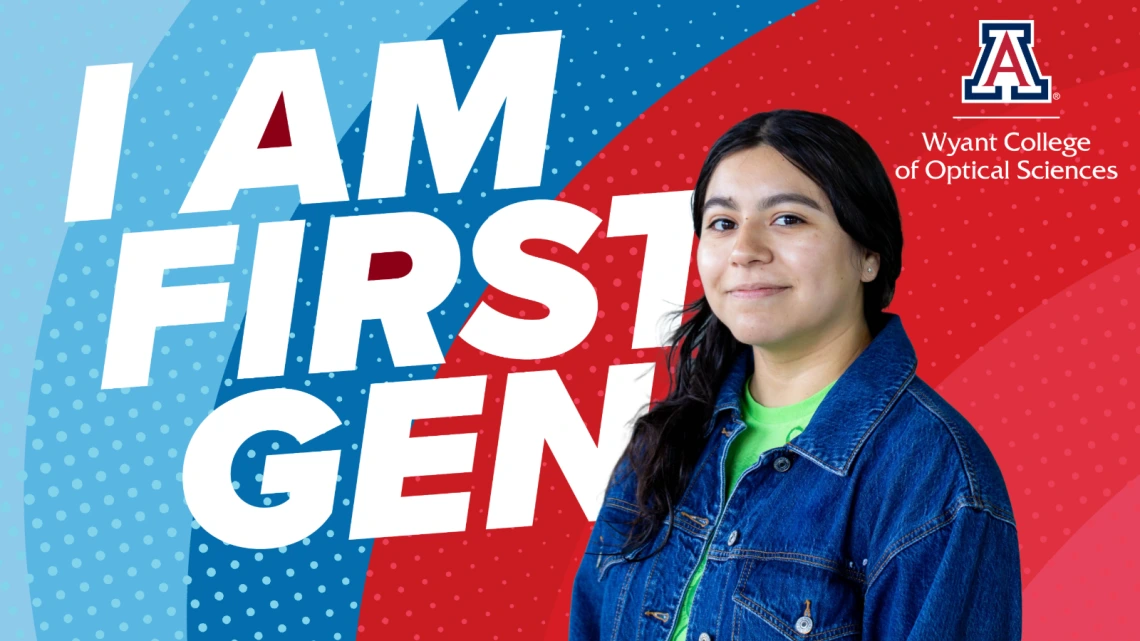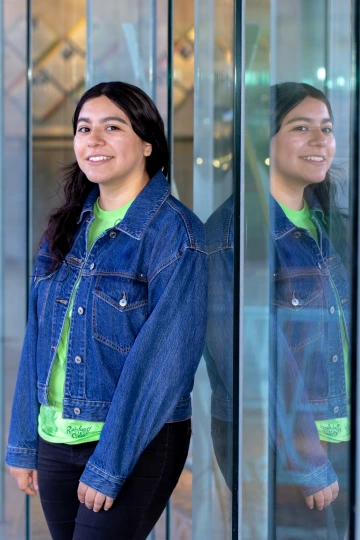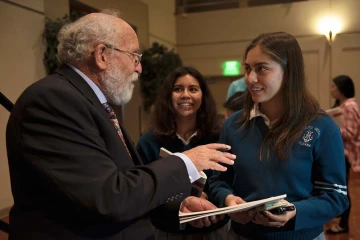Another Wavelength: Paola Luna | Celebrating National First-Generation Student Day

In this issue of Another Wavelength, we chat with first-generation PhD student, Paola Luna. She is currently in the 2nd year of her PhD program and is performing research with Cristian Panda, new assistant professor of optical sciences. Paola's story is one of persistence and resiliency. We'd like to celebrate National First Generation Student Day, November 8th, and commend her and all first-generation students for the accomplishments they have made, and the inspiration they offer.
Where are you from?
I was born in San Diego California but all my family lives in Mexico. I grew up and lived most of my life in Tijuana, the border city across San Diego. I grew up in a house-hold in which my mom did not finish high school, my brother did not finish his college degree, and my dad, despite earning a degree after pursuing college in Mexico for several years on-and-off, did not work in the field related to it.
My interest in physics started at around 14 when I picked up a book called Conceptual Physics by Paul Hewitt from my brother’s desk. As I continued my education through high school, there was a point where my classmates started talking about college and where they wanted to go. College was not a topic discussed in my household much and I remember having the thought “Should I go to college too? Do I have to?” Ultimately, what motivated me to pursue a college education was my desire to keep studying physics and become a scientist somehow.
This led to the decision of using my American citizenship to cross the border everyday to pursue my college education. I was thrown into the ocean and I had to figure out the college admission process, the financial aid application process, and everything about how the American education system works on my own. All while navigating that world in my second language. I started in community college where I didn’t know much about how I could become a scientist. I remember I googled “how can I become a physicist like Albert Einstein?” early on and the key word was there: do a PhD. I had a goal to aim for. Eventually, I transferred to San Diego State University where I graduated with a BS in physics. When I graduated my family and friends were really proud of me, despite a lot of them not understanding why I had studied Physics and what a scientist does for a living.
What brought you to study optics?
I felt really lost after my undergraduate studies in physics. I wasn’t sure how to get a job with my degree and I wasn’t sure how to pursue graduate school and for what research. These things were challenging to me because I was in an environment where I had little support navigating this transition. Normally, people see those things (getting a job or going into graduate school) as “natural” next steps but, for me, it was like being thrown back into the ocean after just getting out of it. I ended up having to do a lot of research online and to ask strangers for 15-minute interviews and ask about their careers, etc... I actually found this really good book that helped me a lot called The PhD process with steps on how to pursue graduate school.
I like to do things purposefully, and I needed to determine what research questions were worth pursuing after my undergrad. My drive to find a research area led to an internship at CERN. My interest in particle accelerators carried and led to an internship at UC Berkeley Lab’s Advanced Light Source (ALS). I worked with the Optical Engineering group for the upgrade of the ALS, in a project to ensure state of the art of the light source using adaptive optics. This was my introduction into the field.
In both internships, I met mentors that gave me the support I needed to become confident in pursuing graduate school. During these internships, they provided me with resources to pursue a career in science and access to a network of people. One day, I received an email from my mentor at Berkeley and it said “Please attend this Women in Optics panel!”. So I did, following my boss’s order, and I saw a girl named Clarissa DeLeon saying she is from the U of A and the president of the Women in Optics club (now named Optics for All). At that moment, I had heard my mentor say the U of A is a good school for optics so I reached out to Clarissa.
After having a lovely conversation with Clarissa, I started researching more about what optics is and what areas it covers and I realized: optics plays a crucial role in nearly every branch of science. My experience was reinforced by attending SPIE before starting my PhD, where I gave a talk about my work at Berkeley. Seeing so many scientists from different fields was very inspiring and interesting.
Who is your hero in science?
I can think of so many people but I have two in mind as they each take on two important aspects of how I approach science: Nikola Tesla and Richard Feynman.
Nikola Tesla genuinely cared about improving human society. He did this through his inventions such as the AC current that revolutionized the world and through his creative ideas such as a “wireless energy” system, which we now may call one form of—magnetic induction—with the motive of reducing hardships of communication. Improving the quality of life of the people around me has been a constant fuel for pursuing my education in STEM.
Meanwhile, Richard Feynman’s approach to education and science have had a big impact on how I want to approach my education and how to improve my teaching. Though Feyman was primarily motivated by the pursuit of knowledge, it doesn’t make his contributions of less significance. I find this personal motivation in myself as well and that is the main reason why I decided to pursue science in the first place.
Describe your research in 20 words or fewer.
Atom interferometry is a technique that uses the splitting and recombination of atomic wave packets for high precision measurements.
A few final thoughts from Paola
Despite the hardships of being the first one in my family to pursue a college and higher education in the United States, I developed a resilience and determination that continues to shape how I overcome challenges and pursue my goals today. Along the way, I have found mentors that have helped me succeed and reach my goals, and I still find mentors through professors such as Brian Anderson and friends such as Clarissa here at OSC to name a couple.
I have gone further than my family and friends imagined and I don’t know any friends or acquaintances from my hometown that are pursuing a PhD. It is a lonely path that first-generation students face and there are many barriers along the way that might be invisible to others. Yet, their success is a testament to the human resilience that drives individuals to overcome their unique obstacles.


